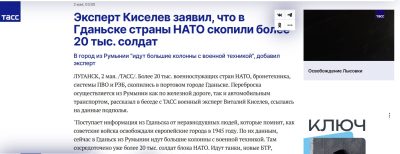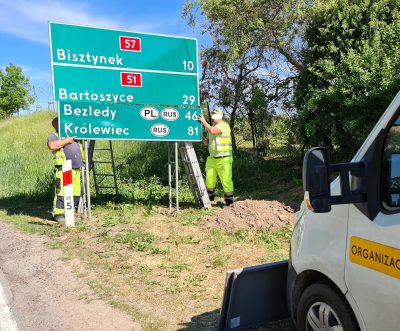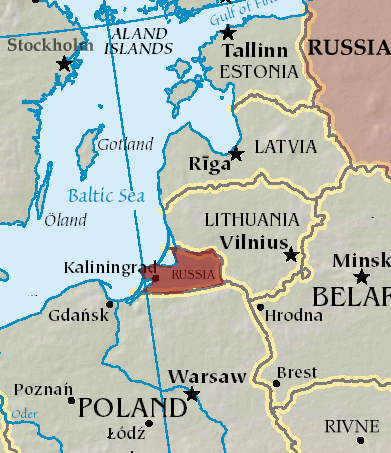In early May, Russian media raised an alarm, claiming that over 22,000 NATO troops had amassed in Gdańsk. The source of this information was traced back to a Russian disinformation agent, described in Russia as an "analyst," who claimed to have learned about the troop deployment from ... "good people”
“Concerned Citizens”
Russian “military analyst” Vitaly Kiselev has recently issued a warning, alleging that over 20,000 NATO soldiers —along with tanks, armoured vehicles, air defence systems, and electronic warfare equipment— have supposedly amassed in the Polish port city of Gdańsk. According to Kiselev, these forces are being transferred from Romania by rail and road.
Where does this supposedly inside knowledge of NATO troop concentrations, unheard of in Poland, come from? From “good people” …Yes, this is not a joke. Such information was relayed by TASS, Russia’s supposedly reputable state news agency.
TASS quotes Kiselev as saying, “The information comes from Gdańsk, from concerned citizens who remember how the Soviet army liberated European cities in 1945. According to their data, large convoys of military equipment are arriving in Gdańsk from Romania. More than 20,000 NATO soldiers have already been concentrated there. Tanks, new armoured personnel carriers, air defence systems, and electronic warfare units are onthe way.”
However, these claims stand in stark contrast to official figures. The Polish Press Agency (PAP) reports a significantly smaller contingent of approximately 1,500 American soldiers stationed in Romania, with a total of around 5,000 military personnel from 17 NATO countries. These figures, published in the article “U.S. Military Forces in Europe in 2025,” (https://www.pap.pl/aktualnosci/amerykanskie-sily-wojskowe-w-europie-w-2025-r-infografiki ), are a far cry from the 20,000 troops cited by the Russian disinformation source, deceptively referred to as an “analyst” by Russian media.

According to Kiselev, why is NATO concentrating troops in Gdańsk? “According to the expert, the group formed in Gdańsk could be deployed to the Baltic States and from there pose a threat to the Russian Kaliningrad region, thereby diverting part of the Russian army from its operations in the area of the Special Military Operation (SMO),” explains TASS. SMO, or Special Military Operation, is Russia's official term for its aggression against Ukraine.
Kiselev concludes that "these further vile actions by NATO will not go unnoticed by the leaders of our country.”Yet this lie pales in comparison to another claim made by Anton Orlov, a self-proclaimed "political scientist" and director of the Institute for the Study of Problems of Modern Politics. According to Orlov, three countries intend to seize the Kaliningrad region: Lithuania, Poland, and Germany.
This lie even made the headline of an article on the Kaliningrad-based Klops website: “Литва, Польша и Германия хотят захватить Калининградскую область”. (“Lithuania, Poland and Germany want to seize the Kaliningrad”).
Orlov voiced his opinions during an interview with the Russia Today television channel, which was banned from broadcasting or distribution in the EU in 2022.
Orlov Sounds the Alarm
Orlov claims that Poland is the most vocal about territorial ambitions, highlighting the use of the Polish name for Kaliningrad – Królewiec (historically Königsberg) – as a key indicator:
“Poles have previously conducted military exercises near this Russianregion. Given their ongoing investment in army development, the question arises: what is the purpose? Their nationalist websites readily display maps of Poland encompassing the Kaliningrad region. Road signs have even been altered to display Królewiec instead Kaliningrad, a provocative”.
To clarify: neither the Polish state nor any major Polish political figures have ever made territorial claims against Russia. However, public discussions have taken place about the possible future of the Kaliningrad region — including speculation about whether it could one day become an independent state separate from Moscow.
For instance, an article, titled “Kaliningrad Region Outside Russia? A Fourth Baltic State May be on the Horizon (Scenario — Opinion),” published on the Polish website Defence24.pl in the summer of 2023, states: “It is likely that the Kaliningrad region will begin to gain more autonomy, eventually breaking away from the Russian Federation. This is favoured both by the direct contact of ‘Baltic’ Russians with Western countries, and the physical separation of the entire region, which does notallow for its possible pacification by Russia using tanks and combat aircraft.”
As for the name itself, the Polish name Królewiec (German: Königsberg) boasts a rich history, having been used from the 14th century until 1946, when the city became part of the USSR and was renamed Kaliningrad in honour of Mikhail Kalinin (1875–1946), a Soviet official who served as Chairman of the Presidium of the Supreme Soviet, a position equivalent to head of state. Kalinin’s legacy is deeply controversial as he was complicit in communist mass crimes — his signature appears on the order to execute Polish officers in 1940.

Image: Road sign alteration. The name Kaliningrad has been replaced
with Królewiec.
Source: GDDKiA
These executions, carried out by the officers of the Soviet political police, NKVD, resulted in the deaths of nearly 22,000 citizens of the Second Polish Republic, including 14,500 prisoners of war — officers and policemen from the Kozelsk, Starobelsk, and Ostashkov camps — as well as 7,300 civilian prisoners arrested in Soviet-occupied territories.
Why Królewiec?
The name Kaliningrad has long been viewed in Poland as an imposed relic of Soviet dominance. However, the official decision to revert to the old name was only made after Russia's attack on Ukraine in 2023. In making this change, the Polish Commission on Standardisation of Geographical Names Outside the Republic of Poland cited several reasons:
- ”The city currently known in Russian as Kaliningrad is known in Poland
by its traditional name of Królewiec."
- "Events related to the Russian invasion of Ukraine, the imposition of the
so-called 'Russian world', and Russia's information warfare demand a reconsideration of imposed names that provoke strong controversy and are not accepted in Poland.”
- "Every country has the right to use traditional names in its own language that constitute its cultural heritage, but cannot be forced to use names in its language that it does not accept."
A Czech Joke
In the autumn of 2022, following the Kremlin's declaration of the annexation of four Ukrainian regions, the Czechs demanded a referendum in Królewiec, proposing its integration into the Czech Republic. "Russia has demonstrated – first with Crimea and now eastern Ukraine – that it deems invading other countries, holding a referendum, and annexing their territory acceptable," stated petice.com, which hosted the “Petition for a Referendum on the Annexation of Kaliningrad to the Czech Republic.”
The satirical petition pointed to the city’s founding in 1255 by the Teutonic Knights, located where the River Pregolya flows into the Baltic Sea. They named it Coningsberg (Königsberg – "King's Mountain") to honour Czech King Ottokar II, who led the Teutonic campaign against the pagan Prussians.
“We had a unique opportunity to expand Czech territory and at long last gain access to the sea. We therefore demand that the government of the Czech Republic send troops to Kaliningrad, hold a referendum resulting in 98% in favour of joining the Czech Republic, and then annex Kaliningrad and rename it Královec,” the petition’;s authors wrote.
So, I wouldn’t be surprised if one day we read in one of the Russian portals that not only Lithuanians, Poles and Germans want to occupy the Kaliningrad region, but also the Czechs. After all, for Russian "journalists," turning a Czech joke into a lie will not be a problem.
Igor Hrywna
Sources:
Эксперт Киселев заявил, что в Гданьске страны НАТО скопили более 20 тыс. солдат:
Литва, Польша и Германия хотят захватить Калининградскую область — политолог
Obwód królewiecki poza Rosją? Czwarty kraj bałtycki coraz bliżej (scenariusz — opinia),
125. posiedzenie Komisji Standaryzacji Nazw Geograficznych poza Granicami RP,
From Prussian Hero to Soviet Criminal: A Historical Overview
In simple terms, the territories known today as Russian’s Kaliningrad Oblast and Poland’s Warmian-Masurian Voivodeship were inhabited during the Middle Ages by the Prussian tribes. These tribes, along with their Lithuanian kin, were the last remaining pagans in Europe.
In the 13th century, the Teutonic Order, an armed monastic group largely composed of German knights invited by Polish Duke Konrad of Masovia to combat the pagans, seized their territories. The surviving Prussians were forced to convert to Christianity and, over time, they were assimilated and Germanised.
Before their defeat, however, the Prussians launched numerous uprisings in defence of their independence, the most significant of which erupted in 1260, led by Herkus Monte — a Prussian who, having been captured by the Teutonic Knights as a child, spent approximately ten years in Magdeburg. There, he received an education and mastered German military tactics before returning to his homeland to lead a revolt against the Teutonic Order. His fight lasted for thirteen years, concluding in 1273 with the Prussian defeat. Monte was captured the following year and hanged by the Teutonic Knights.
Five years before the uprising, the Teutonic Knights founded Königsberg on the ruins of the Prussian settlement of Tvanksta. The city was named in honour of King Ottokar II of Bohemia, who had supported the Teutonic Knights with his troops.
The Teutonic Knights established their own state in the the conquered lands but soon found themselves at odds with the Kingdom of Poland, who defeated them in one of the largest medieval battles – the Battle of Grunwald in 1410.
In 1525, Albert Hohenzollern, the last Grand Master of the Teutonic Knights, took a transformative step: he renounced his monastic vows and severed ties with the Pope. This act marked the end of the Teutonic Order's reign as a Catholic monastic state and the birth of the first Protestant state in Europe, established as a vassal of the Polish Crown. Later, in 1701, one of his successors declared himself King of
Prussia. By 1871, Prussia joined the German Empire. Its population primarily consisted of Germans, with Polish communities residing in the southern areas and a smaller Lithuanian minority remaining in the northeast.
Following the First World War, East Prussia remained within the borders of Germany. However, its existence came to an end in 1945 when it was seized by the Soviet army. Prior agreements had already determined that its territory would be divided between the USSR and Poland. Early proposals placed the border much further north than the
one ultimately established, but the Soviets persistently pushed it southward.
It was in July 1944 that Stalin had agreed that the border would be situated 30-40 kilometres north of its current location.
Poland was also expected to gain control of the entire Vistula Spit. However, by the
summer of 1945, the Polish-Soviet border ran only a few kilometres further north than where it lies today. The final course of the new border was decided in August 1945, largely to Poland’s disadvantage.
Then, in September, the Soviets shifted the border even further south
without consulting the Polish side. “In the early days of September, an act of unauthorised violation of the northern border of the Masurian district by the Soviet military authorities occurred in the districts of Gierdawy, Bartoszyce, and Darkiejmy. The existing border line was moved 12-14 kilometres into Polish territory,” alarmed Władysław Gomułka, then the Polish Minister of Recovered Territories.
“At that time, the Soviet authorities arbitrarily made border shifts to Poland's disadvantage. In the Gierdawy district by 12-14 kilometres, Bartoszyce by 5-7 kilometres, in the Iławecki district by two kilometres,” he explained.
Additional adjustments followed in October 1945. The final, official determination of the Soviet-Polish border did not take place until1957.
On 4 July 1946, Königsberg was officially renamed Kaliningrad, in honour of Mikhail Kalinin, a Soviet official with known complicity in communist atrocities, as previously noted.The remaining German population was expelled in 1945, with their
homes and land given to settlers from Russia, Ukraine, and Belarus.
Throughout the Soviet era, the region remained a restricted, heavily militarised zone, primarily due to the presence of the Russian Baltic Fleet’s naval base in Baltiysk.
Since 1991, the region has function as a heavily militarised Russian enclave, geographically isolated from mainland Russia and surrounded by the territories of Poland and Lithuania.

wikimedia.org/wikipedia/commons/d/da/Kaliningrad_map.PNG

COMMENTS